Molecular Biology Assignment: Ethical Issues in CRISPR Technologies
VerifiedAdded on 2023/04/04
|7
|1640
|113
Report
AI Summary
This report delves into the ethical implications of CRISPR technology, using Dr. He Jiankui's controversial claim of gene-editing human embryos as a focal point. The report outlines the scientific basis of Dr. He's work, including his claims of creating HIV-resistant babies through modification of the CCR5 gene. It critically examines the ethical concerns raised by the scientific community and the potential risks to the genetically edited babies. Furthermore, the report explores alternative methods for parents to conceive HIV-free babies, such as assisted reproduction technologies. It also discusses the future of CRISPR technology, its potential applications in treating genetic diseases, and the ethical considerations surrounding its use. The report highlights the importance of ethical standards and responsible scientific practice in the advancement of gene-editing technologies, emphasizing the need for careful consideration of the impact of such technologies on society and future generations.
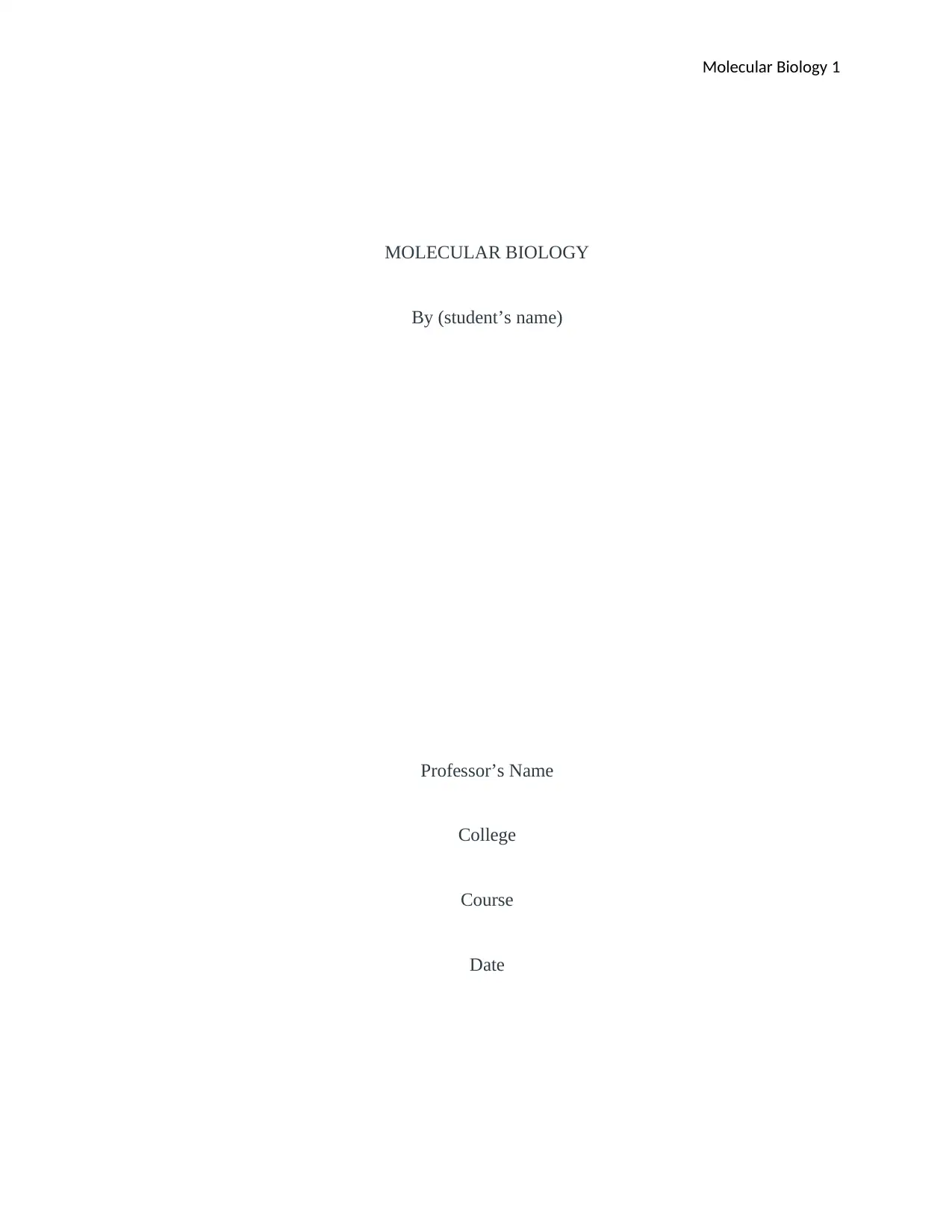
Molecular Biology 1
MOLECULAR BIOLOGY
By (student’s name)
Professor’s Name
College
Course
Date
MOLECULAR BIOLOGY
By (student’s name)
Professor’s Name
College
Course
Date
Paraphrase This Document
Need a fresh take? Get an instant paraphrase of this document with our AI Paraphraser
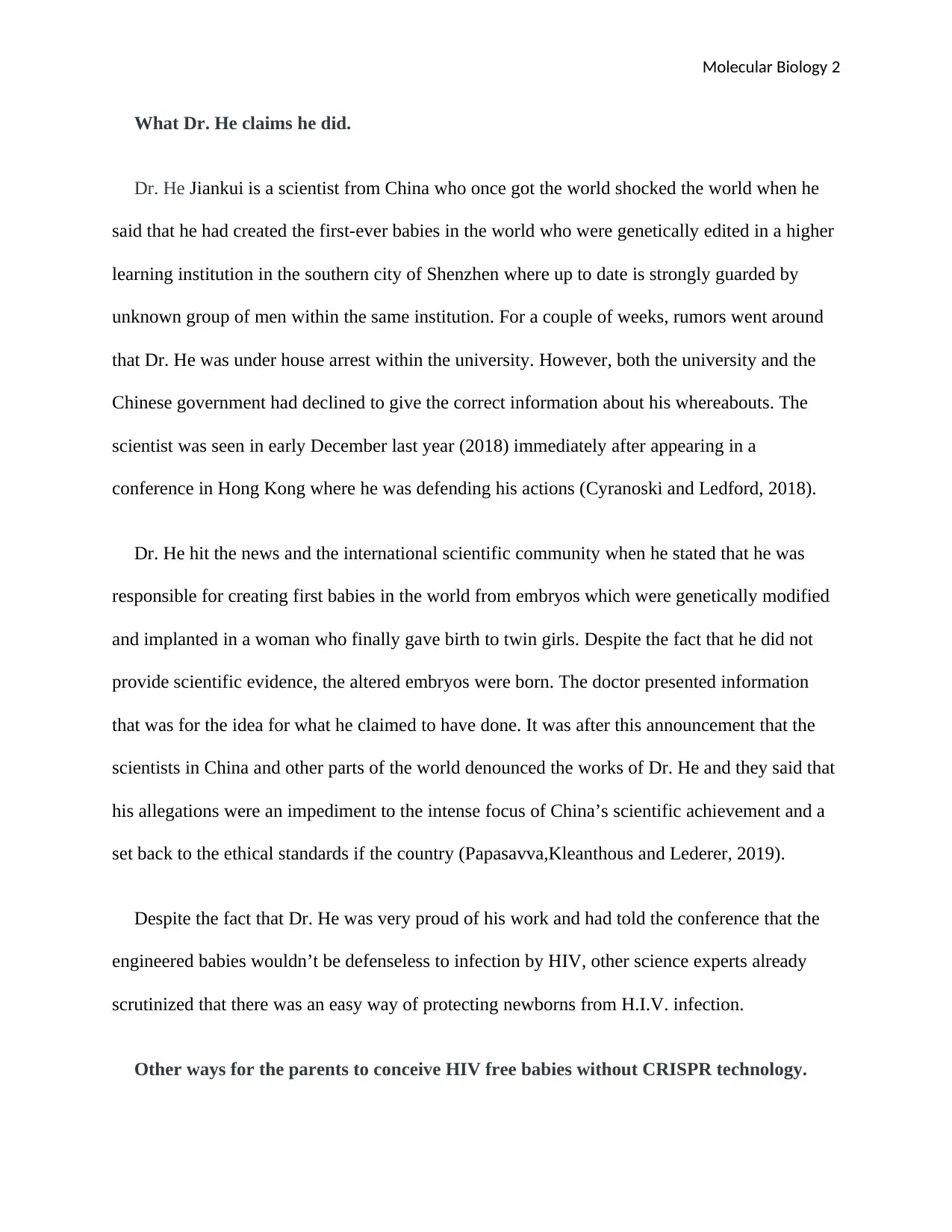
Molecular Biology 2
What Dr. He claims he did.
Dr. He Jiankui is a scientist from China who once got the world shocked the world when he
said that he had created the first-ever babies in the world who were genetically edited in a higher
learning institution in the southern city of Shenzhen where up to date is strongly guarded by
unknown group of men within the same institution. For a couple of weeks, rumors went around
that Dr. He was under house arrest within the university. However, both the university and the
Chinese government had declined to give the correct information about his whereabouts. The
scientist was seen in early December last year (2018) immediately after appearing in a
conference in Hong Kong where he was defending his actions (Cyranoski and Ledford, 2018).
Dr. He hit the news and the international scientific community when he stated that he was
responsible for creating first babies in the world from embryos which were genetically modified
and implanted in a woman who finally gave birth to twin girls. Despite the fact that he did not
provide scientific evidence, the altered embryos were born. The doctor presented information
that was for the idea for what he claimed to have done. It was after this announcement that the
scientists in China and other parts of the world denounced the works of Dr. He and they said that
his allegations were an impediment to the intense focus of China’s scientific achievement and a
set back to the ethical standards if the country (Papasavva,Kleanthous and Lederer, 2019).
Despite the fact that Dr. He was very proud of his work and had told the conference that the
engineered babies wouldn’t be defenseless to infection by HIV, other science experts already
scrutinized that there was an easy way of protecting newborns from H.I.V. infection.
Other ways for the parents to conceive HIV free babies without CRISPR technology.
What Dr. He claims he did.
Dr. He Jiankui is a scientist from China who once got the world shocked the world when he
said that he had created the first-ever babies in the world who were genetically edited in a higher
learning institution in the southern city of Shenzhen where up to date is strongly guarded by
unknown group of men within the same institution. For a couple of weeks, rumors went around
that Dr. He was under house arrest within the university. However, both the university and the
Chinese government had declined to give the correct information about his whereabouts. The
scientist was seen in early December last year (2018) immediately after appearing in a
conference in Hong Kong where he was defending his actions (Cyranoski and Ledford, 2018).
Dr. He hit the news and the international scientific community when he stated that he was
responsible for creating first babies in the world from embryos which were genetically modified
and implanted in a woman who finally gave birth to twin girls. Despite the fact that he did not
provide scientific evidence, the altered embryos were born. The doctor presented information
that was for the idea for what he claimed to have done. It was after this announcement that the
scientists in China and other parts of the world denounced the works of Dr. He and they said that
his allegations were an impediment to the intense focus of China’s scientific achievement and a
set back to the ethical standards if the country (Papasavva,Kleanthous and Lederer, 2019).
Despite the fact that Dr. He was very proud of his work and had told the conference that the
engineered babies wouldn’t be defenseless to infection by HIV, other science experts already
scrutinized that there was an easy way of protecting newborns from H.I.V. infection.
Other ways for the parents to conceive HIV free babies without CRISPR technology.
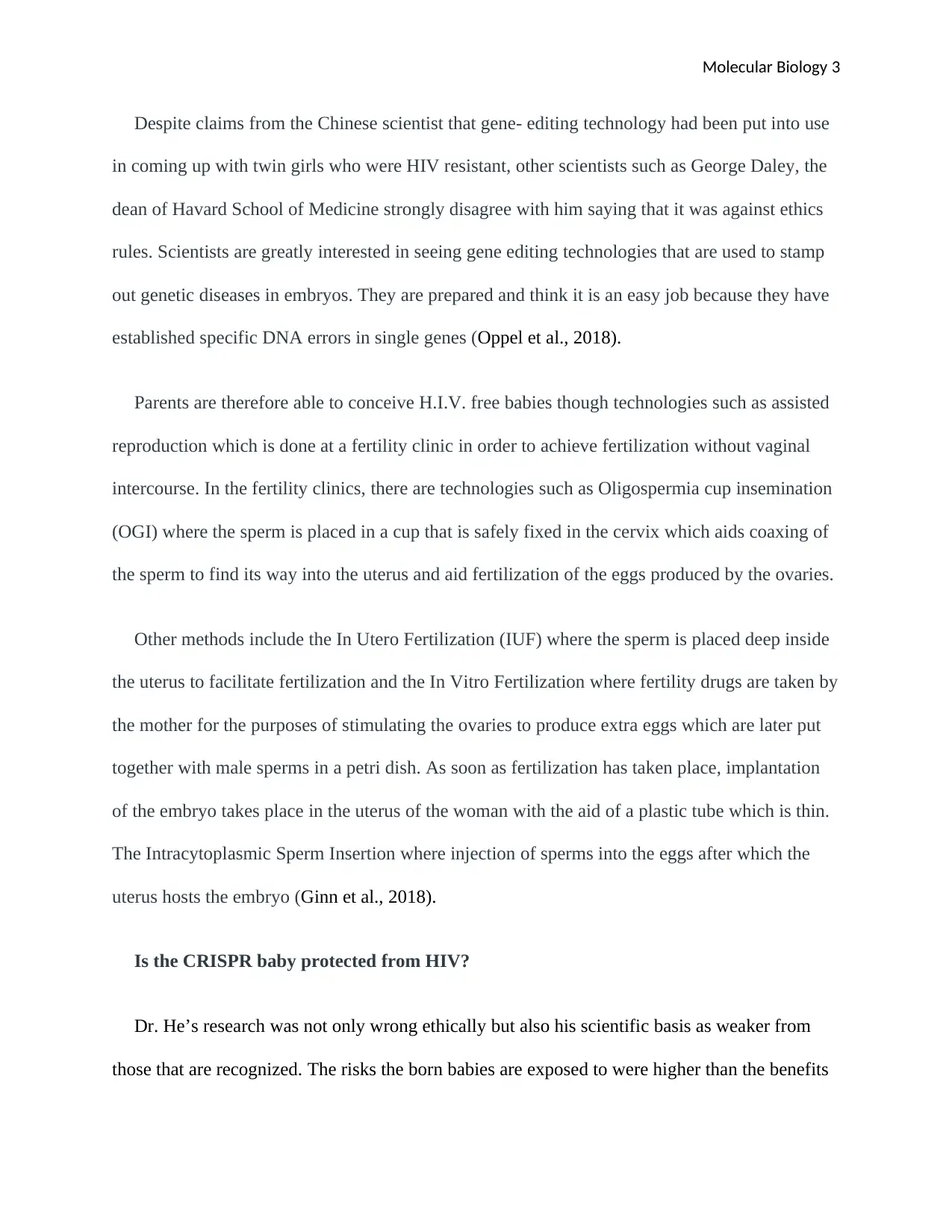
Molecular Biology 3
Despite claims from the Chinese scientist that gene- editing technology had been put into use
in coming up with twin girls who were HIV resistant, other scientists such as George Daley, the
dean of Havard School of Medicine strongly disagree with him saying that it was against ethics
rules. Scientists are greatly interested in seeing gene editing technologies that are used to stamp
out genetic diseases in embryos. They are prepared and think it is an easy job because they have
established specific DNA errors in single genes (Oppel et al., 2018).
Parents are therefore able to conceive H.I.V. free babies though technologies such as assisted
reproduction which is done at a fertility clinic in order to achieve fertilization without vaginal
intercourse. In the fertility clinics, there are technologies such as Oligospermia cup insemination
(OGI) where the sperm is placed in a cup that is safely fixed in the cervix which aids coaxing of
the sperm to find its way into the uterus and aid fertilization of the eggs produced by the ovaries.
Other methods include the In Utero Fertilization (IUF) where the sperm is placed deep inside
the uterus to facilitate fertilization and the In Vitro Fertilization where fertility drugs are taken by
the mother for the purposes of stimulating the ovaries to produce extra eggs which are later put
together with male sperms in a petri dish. As soon as fertilization has taken place, implantation
of the embryo takes place in the uterus of the woman with the aid of a plastic tube which is thin.
The Intracytoplasmic Sperm Insertion where injection of sperms into the eggs after which the
uterus hosts the embryo (Ginn et al., 2018).
Is the CRISPR baby protected from HIV?
Dr. He’s research was not only wrong ethically but also his scientific basis as weaker from
those that are recognized. The risks the born babies are exposed to were higher than the benefits
Despite claims from the Chinese scientist that gene- editing technology had been put into use
in coming up with twin girls who were HIV resistant, other scientists such as George Daley, the
dean of Havard School of Medicine strongly disagree with him saying that it was against ethics
rules. Scientists are greatly interested in seeing gene editing technologies that are used to stamp
out genetic diseases in embryos. They are prepared and think it is an easy job because they have
established specific DNA errors in single genes (Oppel et al., 2018).
Parents are therefore able to conceive H.I.V. free babies though technologies such as assisted
reproduction which is done at a fertility clinic in order to achieve fertilization without vaginal
intercourse. In the fertility clinics, there are technologies such as Oligospermia cup insemination
(OGI) where the sperm is placed in a cup that is safely fixed in the cervix which aids coaxing of
the sperm to find its way into the uterus and aid fertilization of the eggs produced by the ovaries.
Other methods include the In Utero Fertilization (IUF) where the sperm is placed deep inside
the uterus to facilitate fertilization and the In Vitro Fertilization where fertility drugs are taken by
the mother for the purposes of stimulating the ovaries to produce extra eggs which are later put
together with male sperms in a petri dish. As soon as fertilization has taken place, implantation
of the embryo takes place in the uterus of the woman with the aid of a plastic tube which is thin.
The Intracytoplasmic Sperm Insertion where injection of sperms into the eggs after which the
uterus hosts the embryo (Ginn et al., 2018).
Is the CRISPR baby protected from HIV?
Dr. He’s research was not only wrong ethically but also his scientific basis as weaker from
those that are recognized. The risks the born babies are exposed to were higher than the benefits
⊘ This is a preview!⊘
Do you want full access?
Subscribe today to unlock all pages.

Trusted by 1+ million students worldwide
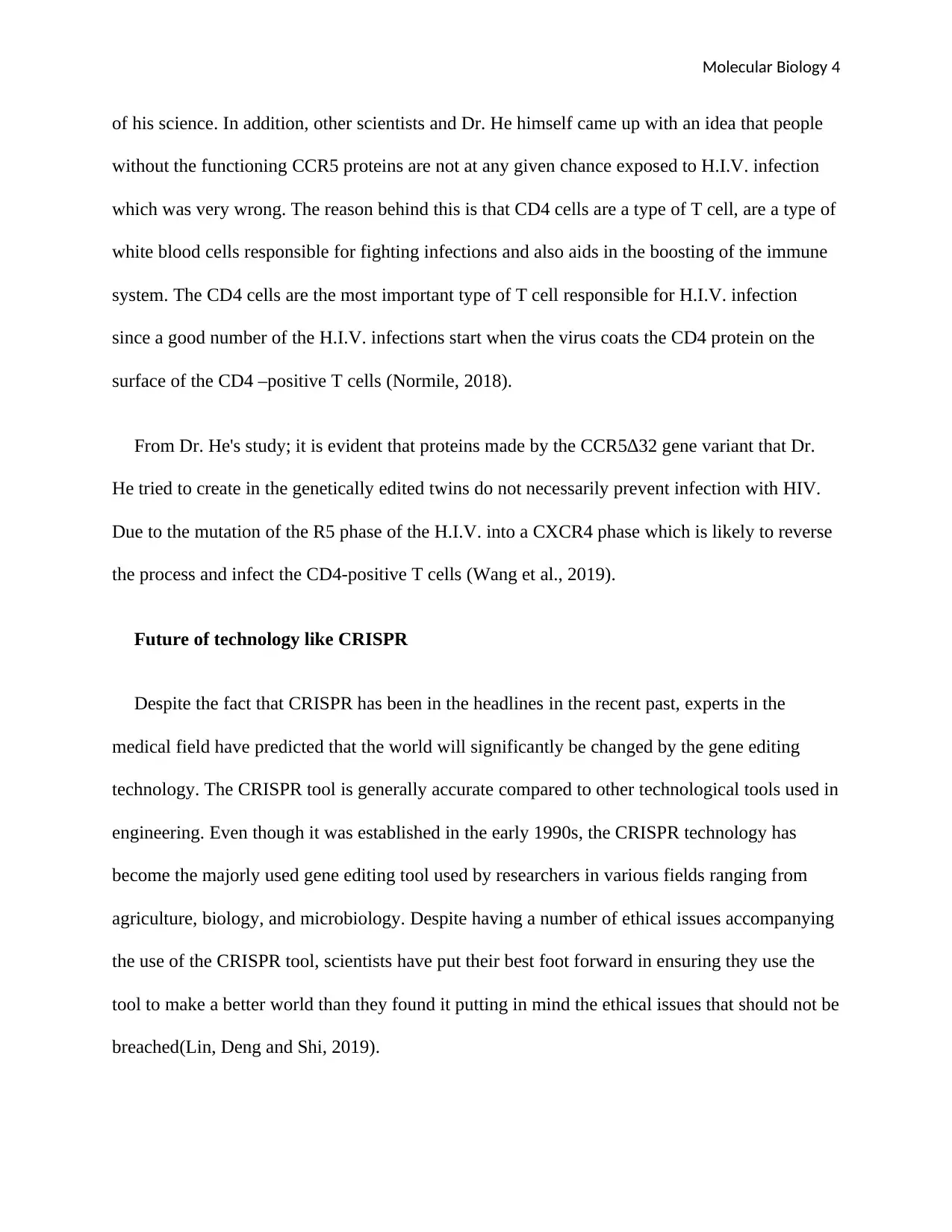
Molecular Biology 4
of his science. In addition, other scientists and Dr. He himself came up with an idea that people
without the functioning CCR5 proteins are not at any given chance exposed to H.I.V. infection
which was very wrong. The reason behind this is that CD4 cells are a type of T cell, are a type of
white blood cells responsible for fighting infections and also aids in the boosting of the immune
system. The CD4 cells are the most important type of T cell responsible for H.I.V. infection
since a good number of the H.I.V. infections start when the virus coats the CD4 protein on the
surface of the CD4 –positive T cells (Normile, 2018).
From Dr. He's study; it is evident that proteins made by the CCR5∆32 gene variant that Dr.
He tried to create in the genetically edited twins do not necessarily prevent infection with HIV.
Due to the mutation of the R5 phase of the H.I.V. into a CXCR4 phase which is likely to reverse
the process and infect the CD4-positive T cells (Wang et al., 2019).
Future of technology like CRISPR
Despite the fact that CRISPR has been in the headlines in the recent past, experts in the
medical field have predicted that the world will significantly be changed by the gene editing
technology. The CRISPR tool is generally accurate compared to other technological tools used in
engineering. Even though it was established in the early 1990s, the CRISPR technology has
become the majorly used gene editing tool used by researchers in various fields ranging from
agriculture, biology, and microbiology. Despite having a number of ethical issues accompanying
the use of the CRISPR tool, scientists have put their best foot forward in ensuring they use the
tool to make a better world than they found it putting in mind the ethical issues that should not be
breached(Lin, Deng and Shi, 2019).
of his science. In addition, other scientists and Dr. He himself came up with an idea that people
without the functioning CCR5 proteins are not at any given chance exposed to H.I.V. infection
which was very wrong. The reason behind this is that CD4 cells are a type of T cell, are a type of
white blood cells responsible for fighting infections and also aids in the boosting of the immune
system. The CD4 cells are the most important type of T cell responsible for H.I.V. infection
since a good number of the H.I.V. infections start when the virus coats the CD4 protein on the
surface of the CD4 –positive T cells (Normile, 2018).
From Dr. He's study; it is evident that proteins made by the CCR5∆32 gene variant that Dr.
He tried to create in the genetically edited twins do not necessarily prevent infection with HIV.
Due to the mutation of the R5 phase of the H.I.V. into a CXCR4 phase which is likely to reverse
the process and infect the CD4-positive T cells (Wang et al., 2019).
Future of technology like CRISPR
Despite the fact that CRISPR has been in the headlines in the recent past, experts in the
medical field have predicted that the world will significantly be changed by the gene editing
technology. The CRISPR tool is generally accurate compared to other technological tools used in
engineering. Even though it was established in the early 1990s, the CRISPR technology has
become the majorly used gene editing tool used by researchers in various fields ranging from
agriculture, biology, and microbiology. Despite having a number of ethical issues accompanying
the use of the CRISPR tool, scientists have put their best foot forward in ensuring they use the
tool to make a better world than they found it putting in mind the ethical issues that should not be
breached(Lin, Deng and Shi, 2019).
Paraphrase This Document
Need a fresh take? Get an instant paraphrase of this document with our AI Paraphraser
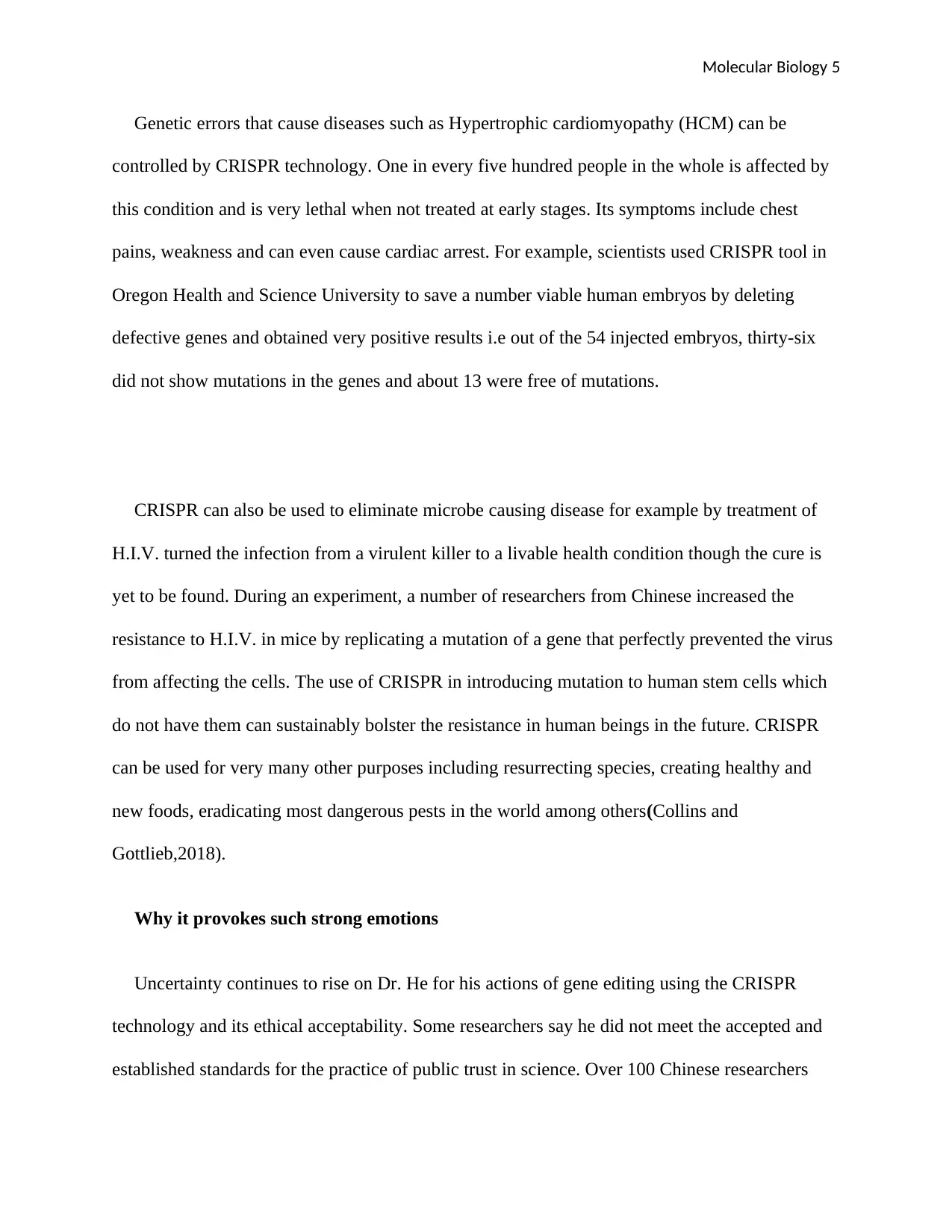
Molecular Biology 5
Genetic errors that cause diseases such as Hypertrophic cardiomyopathy (HCM) can be
controlled by CRISPR technology. One in every five hundred people in the whole is affected by
this condition and is very lethal when not treated at early stages. Its symptoms include chest
pains, weakness and can even cause cardiac arrest. For example, scientists used CRISPR tool in
Oregon Health and Science University to save a number viable human embryos by deleting
defective genes and obtained very positive results i.e out of the 54 injected embryos, thirty-six
did not show mutations in the genes and about 13 were free of mutations.
CRISPR can also be used to eliminate microbe causing disease for example by treatment of
H.I.V. turned the infection from a virulent killer to a livable health condition though the cure is
yet to be found. During an experiment, a number of researchers from Chinese increased the
resistance to H.I.V. in mice by replicating a mutation of a gene that perfectly prevented the virus
from affecting the cells. The use of CRISPR in introducing mutation to human stem cells which
do not have them can sustainably bolster the resistance in human beings in the future. CRISPR
can be used for very many other purposes including resurrecting species, creating healthy and
new foods, eradicating most dangerous pests in the world among others(Collins and
Gottlieb,2018).
Why it provokes such strong emotions
Uncertainty continues to rise on Dr. He for his actions of gene editing using the CRISPR
technology and its ethical acceptability. Some researchers say he did not meet the accepted and
established standards for the practice of public trust in science. Over 100 Chinese researchers
Genetic errors that cause diseases such as Hypertrophic cardiomyopathy (HCM) can be
controlled by CRISPR technology. One in every five hundred people in the whole is affected by
this condition and is very lethal when not treated at early stages. Its symptoms include chest
pains, weakness and can even cause cardiac arrest. For example, scientists used CRISPR tool in
Oregon Health and Science University to save a number viable human embryos by deleting
defective genes and obtained very positive results i.e out of the 54 injected embryos, thirty-six
did not show mutations in the genes and about 13 were free of mutations.
CRISPR can also be used to eliminate microbe causing disease for example by treatment of
H.I.V. turned the infection from a virulent killer to a livable health condition though the cure is
yet to be found. During an experiment, a number of researchers from Chinese increased the
resistance to H.I.V. in mice by replicating a mutation of a gene that perfectly prevented the virus
from affecting the cells. The use of CRISPR in introducing mutation to human stem cells which
do not have them can sustainably bolster the resistance in human beings in the future. CRISPR
can be used for very many other purposes including resurrecting species, creating healthy and
new foods, eradicating most dangerous pests in the world among others(Collins and
Gottlieb,2018).
Why it provokes such strong emotions
Uncertainty continues to rise on Dr. He for his actions of gene editing using the CRISPR
technology and its ethical acceptability. Some researchers say he did not meet the accepted and
established standards for the practice of public trust in science. Over 100 Chinese researchers
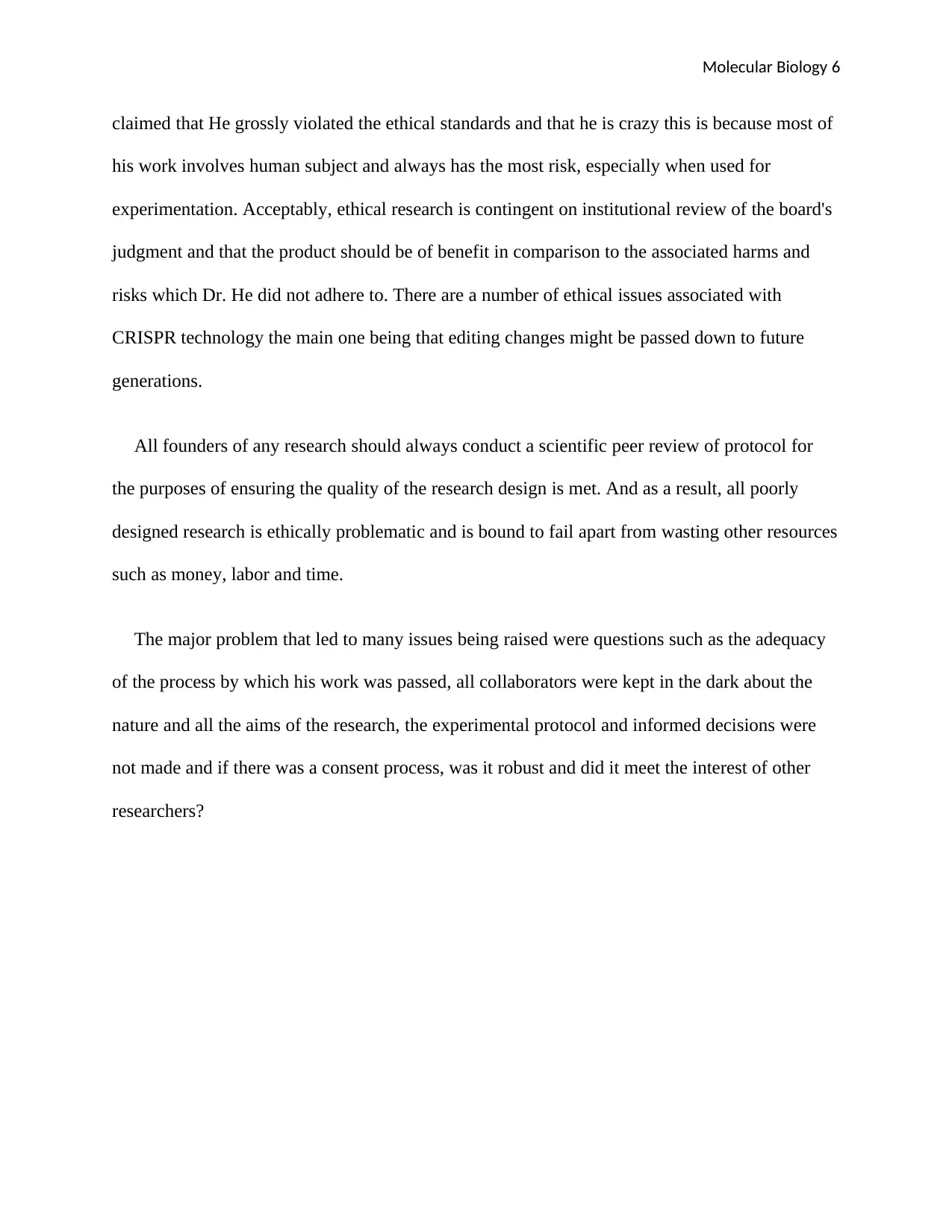
Molecular Biology 6
claimed that He grossly violated the ethical standards and that he is crazy this is because most of
his work involves human subject and always has the most risk, especially when used for
experimentation. Acceptably, ethical research is contingent on institutional review of the board's
judgment and that the product should be of benefit in comparison to the associated harms and
risks which Dr. He did not adhere to. There are a number of ethical issues associated with
CRISPR technology the main one being that editing changes might be passed down to future
generations.
All founders of any research should always conduct a scientific peer review of protocol for
the purposes of ensuring the quality of the research design is met. And as a result, all poorly
designed research is ethically problematic and is bound to fail apart from wasting other resources
such as money, labor and time.
The major problem that led to many issues being raised were questions such as the adequacy
of the process by which his work was passed, all collaborators were kept in the dark about the
nature and all the aims of the research, the experimental protocol and informed decisions were
not made and if there was a consent process, was it robust and did it meet the interest of other
researchers?
claimed that He grossly violated the ethical standards and that he is crazy this is because most of
his work involves human subject and always has the most risk, especially when used for
experimentation. Acceptably, ethical research is contingent on institutional review of the board's
judgment and that the product should be of benefit in comparison to the associated harms and
risks which Dr. He did not adhere to. There are a number of ethical issues associated with
CRISPR technology the main one being that editing changes might be passed down to future
generations.
All founders of any research should always conduct a scientific peer review of protocol for
the purposes of ensuring the quality of the research design is met. And as a result, all poorly
designed research is ethically problematic and is bound to fail apart from wasting other resources
such as money, labor and time.
The major problem that led to many issues being raised were questions such as the adequacy
of the process by which his work was passed, all collaborators were kept in the dark about the
nature and all the aims of the research, the experimental protocol and informed decisions were
not made and if there was a consent process, was it robust and did it meet the interest of other
researchers?
⊘ This is a preview!⊘
Do you want full access?
Subscribe today to unlock all pages.

Trusted by 1+ million students worldwide
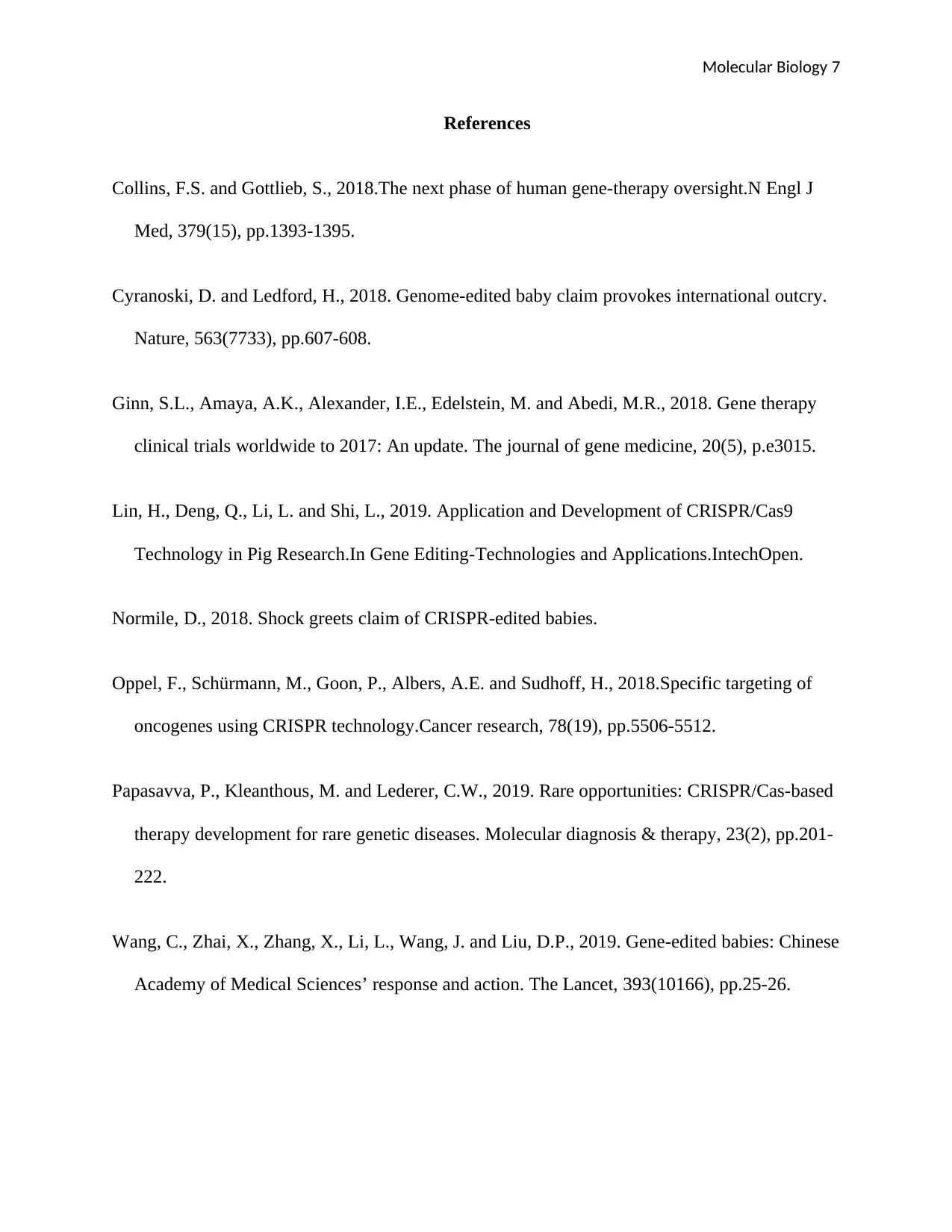
Molecular Biology 7
References
Collins, F.S. and Gottlieb, S., 2018.The next phase of human gene-therapy oversight.N Engl J
Med, 379(15), pp.1393-1395.
Cyranoski, D. and Ledford, H., 2018. Genome-edited baby claim provokes international outcry.
Nature, 563(7733), pp.607-608.
Ginn, S.L., Amaya, A.K., Alexander, I.E., Edelstein, M. and Abedi, M.R., 2018. Gene therapy
clinical trials worldwide to 2017: An update. The journal of gene medicine, 20(5), p.e3015.
Lin, H., Deng, Q., Li, L. and Shi, L., 2019. Application and Development of CRISPR/Cas9
Technology in Pig Research.In Gene Editing-Technologies and Applications.IntechOpen.
Normile, D., 2018. Shock greets claim of CRISPR-edited babies.
Oppel, F., Schürmann, M., Goon, P., Albers, A.E. and Sudhoff, H., 2018.Specific targeting of
oncogenes using CRISPR technology.Cancer research, 78(19), pp.5506-5512.
Papasavva, P., Kleanthous, M. and Lederer, C.W., 2019. Rare opportunities: CRISPR/Cas-based
therapy development for rare genetic diseases. Molecular diagnosis & therapy, 23(2), pp.201-
222.
Wang, C., Zhai, X., Zhang, X., Li, L., Wang, J. and Liu, D.P., 2019. Gene-edited babies: Chinese
Academy of Medical Sciences’ response and action. The Lancet, 393(10166), pp.25-26.
References
Collins, F.S. and Gottlieb, S., 2018.The next phase of human gene-therapy oversight.N Engl J
Med, 379(15), pp.1393-1395.
Cyranoski, D. and Ledford, H., 2018. Genome-edited baby claim provokes international outcry.
Nature, 563(7733), pp.607-608.
Ginn, S.L., Amaya, A.K., Alexander, I.E., Edelstein, M. and Abedi, M.R., 2018. Gene therapy
clinical trials worldwide to 2017: An update. The journal of gene medicine, 20(5), p.e3015.
Lin, H., Deng, Q., Li, L. and Shi, L., 2019. Application and Development of CRISPR/Cas9
Technology in Pig Research.In Gene Editing-Technologies and Applications.IntechOpen.
Normile, D., 2018. Shock greets claim of CRISPR-edited babies.
Oppel, F., Schürmann, M., Goon, P., Albers, A.E. and Sudhoff, H., 2018.Specific targeting of
oncogenes using CRISPR technology.Cancer research, 78(19), pp.5506-5512.
Papasavva, P., Kleanthous, M. and Lederer, C.W., 2019. Rare opportunities: CRISPR/Cas-based
therapy development for rare genetic diseases. Molecular diagnosis & therapy, 23(2), pp.201-
222.
Wang, C., Zhai, X., Zhang, X., Li, L., Wang, J. and Liu, D.P., 2019. Gene-edited babies: Chinese
Academy of Medical Sciences’ response and action. The Lancet, 393(10166), pp.25-26.
1 out of 7
Related Documents
Your All-in-One AI-Powered Toolkit for Academic Success.
+13062052269
info@desklib.com
Available 24*7 on WhatsApp / Email
![[object Object]](/_next/static/media/star-bottom.7253800d.svg)
Unlock your academic potential
Copyright © 2020–2025 A2Z Services. All Rights Reserved. Developed and managed by ZUCOL.





